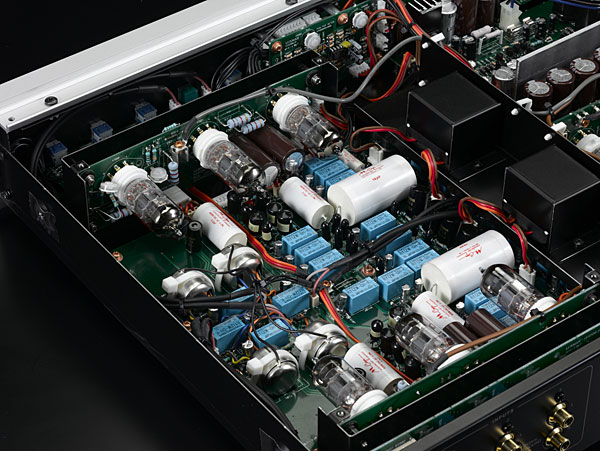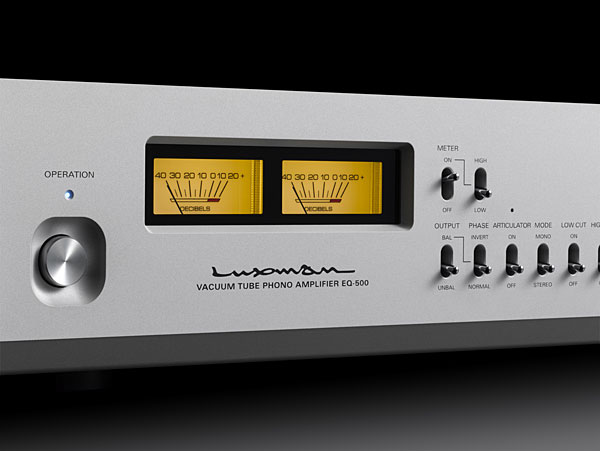| Columns Retired Columns & Blogs |
I have been keeping my eye on this baby and figured if it went unremarked upon, I might find one on the cheap.
So, Art, thanks for ruining my plan!
It would have worked, too, if not for that meddling reviewer.
;-D
Also from 1971, also on EMI, was the eponymous debut album by the Electric Light Orchestra (Harvest SHVL 797), which was, at the time, the English band the Move (with whom the band featuring a young John Atkinson on bass once shared a bill in the English town of Bedford)—an LP that sounded unusually compelling through this phono stage. The textures of the close-miked violin, cellos, and double bass in "Queen of the Hours" were almost overwhelming—a very pleasant overdose—not to mention the color and texture of the lead vocal by a very young Jeff Lynne.
Also from 1971 was Brain Capers, the fourth album by the West Midlands band Mott the Hoople (LP, Atlantic SD 8304), and probably the last one to find them at their shambolic best. The Luxman served this record well, too, with excellent drive and pacing, and a fantastic sense of Ian Hunter's schreien-sang performance of the nearly perfect "Sweet Angeline." I'd been prompted to reach for this record by the sad death, days before, of MTH drummer Dale "Buffin" Griffin; suffice it to say, Griffin's unique combination of limberness, occasional Bonham-esque whomp, and galloping drive was put across to great effect.

From there I proceeded to the great Jacques Loussier recording Play Bach No.1 (Decca/Speakers Corner SSL 40.500) and its first track, Prelude 1 from Book I of Bach's The Well-Tempered Clavier. The manner in which the EQ-500 pulled subtle musical details out of an ink-black background was astonishing—and very much appreciated: While I certainly can't say this was the first time I'd heard double-bassist Pierre Michelot's very softly recorded improvisations in the intro, it was the first time I could really appreciate them as the bleeding chunks of melody they are, served here with percussive impact and sonic heft. Of course, Loussier's limber yet forceful pianism was also well served—and, again, there were equal, generous measures of melodicism, beautiful timbral colors, and sheer drive.
And this was only my first night with the Luxman—used with the TSD 15 straight in, and with the EQ-500's Cartridge knob set to MC High, and its Gain knob to 36dB.
Keeping with the TSD 15 for a while longer, I returned to Joanna Newsom's latest album, Divers (LP, Drag City DC561): a good recording, but one that skates right up to the edge of brightness. Through the Luxman, "Sapokanikan" sounded sensationally good. Newsom's voice retained its occasionally edgy squeakiness, but without going overboard into unnaturally exaggerated sibilants—it had timbral and textural substance, and just the right degree of spatial presence. (And during her overdubbed harmonies, the extra Newsoms were spread slightly to either side of the image of her central, lead vocal.) Percussion accents and lower-range piano chords had enough bass depth and foundation—I wouldn't have wanted a hair less—and those sounds were put across with excellent touch. A really great performance by the Lux!
What was gained (haw) by substituting the Hommage T2 for the Luxman's MC transformers and, concomitantly, setting the Lux's Cartridge knob to MM, for an input impedance of 47k ohms? A richer piano sound (especially from the left hand), greater depth to the electric bass and bass drum, a more pronounced sense of force from virtually all instruments, and a larger sense of scale overall. Okay: the EQ-500's transformers could still be improved on by using a $5000 transformer designed specifically for the TSD 15.
But when I switched over to my Shindo SPU pickup head, used straight into the Luxman's MC Low input—with gain set to 40dB—the results were on a par with what I'd heard from the EMT-Hommage-Luxman combination: By itself, the EQ-500 worked with the Ortofon-based Shindo cartridge to produce superb touch, color, dynamic ease, and scale, plus truly impressive bass depth.
Driven by the Shindo SPU, the EQ-500 sounded distinctly up-front, present, forceful, colorful, and timbrally and texturally rich—a richness that didn't come at the expense of clarity and musical detail, as I learned when I put on Sonny Meets Hawk!, by Sonny Rollins and Coleman Hawkins (LP, RCA Living Stereo/Classic LSP-2712). Listening to "Yesterdays," in addition to reveling in the presence and enormous scale of both men's tenor saxophones, I noticed for the first time the double-stops played by bassist Bob Cranshaw, his instrument reproduced with rare weight, and his occasional forays into the double bass's highest register. And the piano solo in "All the Things You Are" by my late neighbor and friend, Paul Bley, was presented with Paul's temporal creativity intact: his use of pauses was served by the Luxman's excellent timing, as were his tone and touch. This very direct LP sounded wonderful through the EQ-500.

The Luxman also worked well with my EMT OFD-series mono pickup heads, with or without the EMT transformer in tow. (As with EMT's stereo cartridge, the Hommage T2 contributed to bass weight, impact, and overall juice, but the Luxman EQ-500 on its own remained excellent in those regards.) The EMT OFD is a high-output MC cartridge, so I used MC High and the lowest gain setting (36dB) when driving the EQ-500 directly, without the transformer. Also, EMTs are rare true-mono cartridges: signal appears only on their right-channel output pins; their left-channel pins carry nothing. In some previous installations, normal (read: non–vintage-savvy) phono preamps have responded to this left-channel nothingness by blending into the music a nice, loud hum, but not so here: Using the EMT OFD 15, and with the EQ-500 set for stereo, there was music in my right loudspeaker and dead silence in the left; flipping the Luxman's Mode switch to Mono gave me the same music in both channels.
And fine music it was. A French pressing of guitarist Regino Sainz de la Maza playing Rodrigo's Concierto de Aranjuez with the Manuel de Falla Orchestra conducted by Cristóbal Halffter (LP, RCA Victor 430.625) produced crazily beautiful colors and textures, and world-class touch and impact, especially on the solo instrument—and on the occasional pizzicato strings behind it.
Conclusions
In my first attempt at writing this review, I remarked on the Luxman EQ-500's wealth of controls and input/output options by observing: "If you don't think that's enough, there's something wrong with you." I changed my mind when it occurred to me that, for all its undeniable flexibility, this Luxman phono preamp doesn't cater to the collector of 78rpm records with any of the various de-emphasis curves for that format—nor does it offer any of the alternate LP curves, such as the not-uncommon curve associated with early US Columbias. (Most people who know me are aware that the floor of my listening room, and of other rooms in my house, are strewn with carton upon carton of records for which I have no shelf space; it may have been one of my near-daily toe-stubbings that heralded this realization.) Thus, for a small handful of hobbyists, the EQ-500 isn't quite "the last phono preamp you'll ever need to buy."
But for everyone else—and especially for the LP enthusiast who uses an analog front end with multiple tonearms and an assortment of cartridges—it's difficult to imagine another contemporary product offering this combination of flexibility and superior sound. In addition to being a pure delight to use, it was easily one of the best-sounding, most musical phono preamps I've ever had in my system. If your budget can stretch this far, the Luxman EQ-500 is a must-hear.

I have been keeping my eye on this baby and figured if it went unremarked upon, I might find one on the cheap.
So, Art, thanks for ruining my plan!
It would have worked, too, if not for that meddling reviewer.
;-D